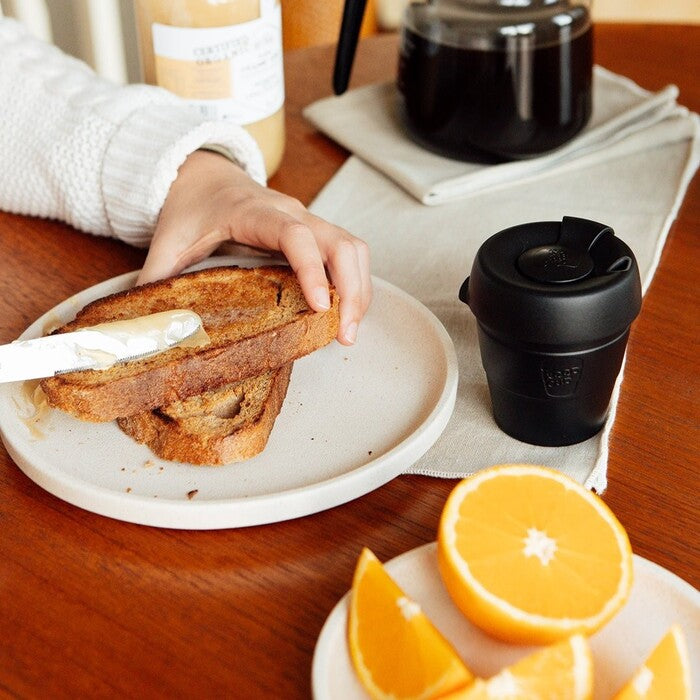Nowadays the Keep Cup is a fixture in many offices and homes, and can be seen in cafes, parks, on the train ... pretty much anywhere people might be drinking coffee. But it really wasn't so long ago that plastic-lined paper cups were the only option for the coffee drinker on the go. With the majority of disposable coffee cups being non-recyclable, this meant that many of these cups were destined for the landfill.
The invention of the KeepCup changed all of that. Now a global phenomenon, keepcup have come to define the reusable coffee cup. This Melbourne-borne invention has not only revolutionised the way we drink coffee: it's helped shape how we think about the environment, and empowered millions to take a positive step towards sustainability. Who would have thought that a cup could do so much? Below we'll delve deep into keep cup history, covering how and why it was invented, and why it's so important today.
Who Invented The Keep Cup?

Brother and sister team Jamie and Abigail Forsyth had been in the coffee business for a few years before they came up with the Keep Cup. They opened their first cafe, Bluebag, in Melbourne in 1998, and quickly grew their business into a small chain. Disposable cups were becoming more common, as Melbourne's now famous cafe culture grew, and so they were more than aware of the problems associated with the single use cup.
At this stage reusable coffee cups were mostly limited to the ceramic versions we're all familiar with from the coffee shop. For years, they found they had no choice but to use disposable cups that were available. But in the background they began thinking of how they might be able to step away from single use plastic lined cups: to something that would reflect their passion for the environment, as well as their love of coffee.
As more reusable cups came to market, they trailed a variety of them in their cafe. But nothing seemed to do the job. The reusable cups that were available weren't designed for the speciality, Barista brewed coffee popular in Melbourne, having been developed in the US for filter coffee. This meant they couldn't fit under the group heads of the coffee machine, making it nearly impossible for the Barista to dose correctly. So there was only one option left.
When Were Keep Cups Invented and Why?

In 2007, increasingly concerned with the impact the disposable cups they were using were having on the environment, and frustrated by the cups available on the market, Jamie and Abigail Forsyth began designing their own. The prototypes would eventually develop into the KeepCup. To understand what drove them to keep seeking the perfect reusable coffee cup, it is important to understand their philosophy when thinking about the Keep Cup.
The KeepCup was of course designed to reduce waste, but the company were more ambitious than this. They were trying to achieve a widespread behaviour change with their product. That is, to change people's mindsets from one of us discard to reuse. With cafe culture worldwide taking hold, and having identified that the existing reusable cup market didn't cater for it, they saw an opportunity to capture the world's imagination. With a reusable cup.
Today, it is estimated that the KeepCup is responsible for saving over 1 million disposable cups from landfill every single day. That places them amongst the most effective products invented in the war on waste. But it wasn't just the KeepCups' environmental credentials that made it so popular: far from it. Not only did they identify a gap, they filled it with a product that was genuinely a cut above the rest.
Why Are Keep Cups Good?
Keep cups are designed for Barista style coffee. This means that not only are they available in a range of sizes to accommodate your favourite brew: all but the largest will fit easily under the group head of a commercial espresso machine. This makes them perfect for the cafe environment, enabling their use in high volume cafes and bringing the Keep Cup to everyone.
The push-on lid is revolutionary, completely watertight but super fast to apply. It also allows KeepCup users to enjoy their coffee safely on the go, and baristas to work fast. If used without the lid, the tapered glass edge is designed for drinking coffee, and is as good as any cup. As is the design of the cup, allowing baristas to pour perfectly. And the glass build ensures they are odour and stain resistant.
That's before we even begin with the sustainable qualities of KeepCup. Aside from their more obvious positives, modular design makes them easily repairable, so you never need to buy a new one. But not only are their cups environmentally sound. The company's commitment to low impact manufacturing extends beyond this, and they source their materials and expertise locally where possible. Both co founder Jamie Forsyth and Abigail, now Managing Director, are vocal advocates for environmental issues in Australia.
How Many People Use Keep Cups?

First sold at an underground design market in Melbourne, KeepCup have now sold over 8 million cups in 65 countries worldwide. They have set up local manufacturing rings in the UK, exporting their business philosophy to the other side of the world in the process. Today KeepCup are not only seen all over the world, they have saved countless millions of disposable cups from landfill, and inspired a wave of similar products.
Riding on the popularity of artisan coffee, they created a product that not only changed how we drink coffee, but how we saw the world around us and our place in it. For many, KeepCup is a byword for disposable cup, such is their impact on the coffee, and wider, world. See Alternative Brewing's full range of KeepCups here.
